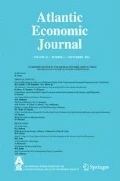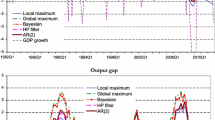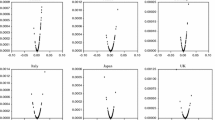Abstract
This paper models asymmetric behavior in GDP growth in the USA, Germany, France, and Japan. It develops smooth transition autoregressive models and interprets nonlinear dynamics in terms of cyclical asymmetries. A procedure for defining data-based, qualitative cyclical regimes from the estimated models is proposed, and generalized impulse response functions are computed to assess to what extent the response to a shock changes over different phases of the cycle.
Similar content being viewed by others
References
Brock, William A.; Hsieh, David A.; Lebaron, Blake. Nonlinear Dynamics, Chaos and Instability, Cambridge: M.I.T. Press, 1991.
Cancelo, José Ramón; Mourelle, Estefanía. “Modelling Cyclical Asymmetries in European Imports,” International Advances in Economic Research, 11, 2, May 2005, pp. 135–47.
Eitrheim, Øyvind; Teräsvirta, Timo. “Testing the Adequacy of Smooth Transition Autoregressive Models,” Journal of Econometrics, 74, 1, September 1996, pp. 59–75.
Emery, Kenneth M.; Koenig, Evan F. “Forecasting Turning Points. Is a Two-State Characterization of the Business Cycle Appropriate?,” Economic Letters, 39, 4, August 1992, pp. 431–5.
Friedman, Milton. “The ‘Plucking Model’ of Business Fluctuations Revisited,” Economic Inquiry, 31, 2, April 1993, pp. 171–7.
Granger, Clive W. J.; Teräsvirta, Timo. Modelling Nonlinear Economic Relationships, Oxford: Oxford University Press, 1993.
Hamilton, James D. “A New Approach to the Economic Analysis of Nonstationary Time Series and the Business Cycle,” Econometrica, 57, 2, March 1989, pp. 357–84.
Hicks, John R. A Contribution to the Theory of the Trade Cycle, Oxford: Clarendon Press, 1950.
Kontolemis, Zenon G. “Does Growth Vary over the Business Cycle? Some Evidence from the G7 Countries,” Economica, 64, 255, August 1997, pp. 441–60.
Koop, Gary; Pesaran, M. Hashem; Potter, Simon M. “Impulse Response Analysis in Nonlinear Multivariate Models,” Journal of Econometrics, 74, 1, September 1996, pp. 119–47.
Mittnik, Stefan; Niu, Zhiqiang. “Asymmetries in Business Cycles: Econometric Techniques and Empirical Evidence,” in Business Cycles: Theories and Empirical Methods, Willi Semmler, (ed.), Dordrecht: Kluwer, 1994, pp. 331–50.
Neftçi, Salih N. “Are Economic Time Series Asymmetric Over the Business Cycle?,” Journal of Political Economy, 92, 2, April 1984, pp. 307–28.
Öcal, Nadir; Osborn, Denise R. “Business Cycle Non-Linearities in UK Consumption and Production,” Journal of Applied Econometrics, 15, 1, January–February 2000, pp. 27–43.
Potter, Simon M. “Asymmetric Economic Propagation Mechanisms,” in Business Cycles: Theories and Empirical Methods, Willi Semmler, (ed.), Dordrecht: Kluwer, 1994, pp. 313–30.
—. “Nonlinear Time Series Modelling: An Introduction,” Journal of Economic Surveys, 13, 5, December 1999, pp. 505–28.
—. “Nonlinear Impulse Response Functions,” Journal of Economic Dynamics and Control, 24, 10, September 2000a, pp. 1425–46.
—. “A Nonlinear Model of the Business Cycle,” Studies in Nonlinear Dynamics and Econometrics, 4, 2, July 2000b, pp. 85–93.
Sichel, Daniel E. “Inventories and the Three Phases of the Business Cycle,” Journal of Business & Economic Statistics, 12, 3, July 1994, pp. 269–77.
Skalin, Joakim; Teräsvirta, Timo. “Another Look at Swedish Business Cycles 1861–1988,” Journal of Applied Econometrics, 14, 4, July–August 1999, pp. 359–78.
—. “Modelling Asymmetries and Moving Equilibriain Unemployment Rates,” Macroeconomic Dynamics, 6, 2, April 2002, pp. 202–41.
Teräsvirta, Timo. “Specification, Estimation, and Evaluation of Smooth Transition Autoregressive Models,” Journal of the American Statistical Association, 89, 425, March 1994, pp. 208–18.
—. “Modeling Economic Relationships with Smooth Transition Regressions,” in Handbook of Applied Economic Statistics, Aman Ullah, David Giles, (eds.), New York: Marcel Dekker, 1998, pp. 507–52.
Teräsvirta, Timo; Anderson, Heather M. “Characterizing Nonlinearities in Business Cycles using Smooth Transition Autoregressive Models,” Journal of Applied Econometrics, 7, 0 Suppl. December 1992, pp. S119–36.
Tong, Howell. Non-Linear Time Series. A Dynamical System Approach, Oxford: Oxford University Press, 1990.
Van Dijk, Dick; Teräsvirta, Timo; Franses, Philip H. “Smooth Transition Autoregressive Models—A Survey of Recent Developments,” Econometric Reviews, 21, 1, April 2002, pp. 1–47.
Zarnowitz, Victor. “What is a Business Cycle?” in The Business Cycle: Theories and Evidence, Michael Belongia, Michelle Garfinkel, (eds.), Boston: Kluwer, 1992, pp. 3–72.




